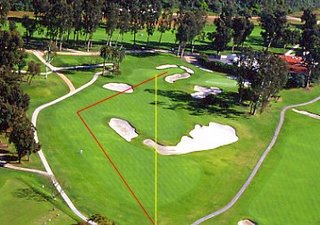Green Committee's - Part 1 of 3 - Will they Listen?
The 10th at Toronto Golf
As my wife said, “What it all boils down to is the club belongs to the members”
I have had a few situations in my career where a green’s committee or chairman only wants me to do their bidding for them. They have decided on the changes that they want to make and how they want it done – all they need is an architect to do it. What they want from their architect is to act as salesman, construction supervisor and mostly a figurehead. They want the rest of the club to assume that all work is approved and directed by the architect while they secretly go about their business behind the scenes. This is unfortunately more common than you would think. After all ask any golfer and they will tell you they know lots about golf architect. For some architects this is an arrangement is acceptable as long as they are well paid, for me it is pure frustration.
In the past I was guilty of trying to please too many people and have certainly learned from this experience. To be truthful, the quality of the work is always comprised – as I stated before what is a horse designed by a committee? A mule. I face an interesting decision along these lines once again with a course I love run by people who want to direct rather than listen. What an interesting dilemma - get involved and hope for committee change - or pass on the work and never work with the club again.
Why have I returned to this topic?
Well I just read through the Report to Members from the Course Committee regarding Toronto Golf Club. They are working with Dr. Martin Hawtree, a man they have hired due to his expertise with H.S. Colt. I was really looking forward to the direction that he offered them. Toronto Golf Club happens to be one of my favourite 5 courses in Canada. The one thing that struck me about the report was there was a great deal of backslapping about how great Toronto Golf is and how lucky to have a Harry Colt design, but very little deals with correcting the lost history and restoration they should be taking on.
Colt bunkers built in 1914
I have a copy of the Colt Plan and have all Colt and Alison’s field notes, so that I’m well versed in what in the history and legacy of the course. I would bet that he gave them a very clear vision and directive of what he wants to do and I would love to see that report. I sure got the impression that the committee has chosen to simplify his thoughts to avoid making drastic moves that could upset membership. I want to make it clear this is MY speculation, but I’ve seen this style of report before. If you can’t make the right decision for fear of upsetting someone – stay off the board and for god’s sakes don’t chair a committee – your doing harm.
I’m only going to give one example that stood out – since I have some historic photos to make a point “Our bunkers are not good examples of Colt’s work”. The committee report talks about repairing the leading lip instead of restoring the bunkers. They have Colt’s instructions on how to build them and how they should look. There are lots more examples in the report, but I just wish clubs would listen to their architects. The results at St. Georges should have been a lesson for all clubs (including Toronto). There was lots of committee involvement ( I like that involvement), but they also trusted (me) the architect to do what is best for the course, and now everyone is pleased with the results including historians.
The role of a green's committee and the green's chairman: http://thecaddyshack.blogspot.com/2006/04/green-committees-part-2-of-3-role-of.html











